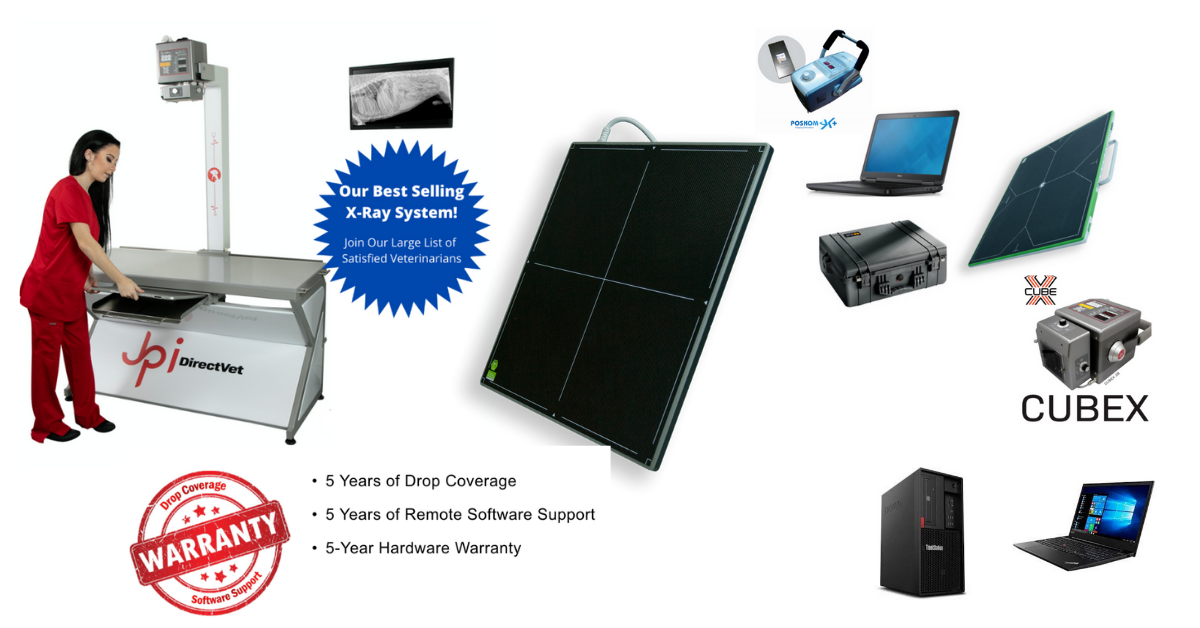How Much Do Today’s Veterinary Digital X-ray Systems Cost?
What Price Range Is to be Expected?
The average price for a DR digital x-ray system in the veterinarian industry ranges from $21,000 to $35,000.
Examples:
DR Plate and system - $21,995
A complete DR system with table, generator, and DR digital x-ray is $29,995
A wireless system for equine or mobile vets - $28,995.
Equipment purchases are one of the most important investments a veterinary practice will make, so it’s important to ensure that the price makes sense for the business.
This doesn’t necessarily mean that the cheapest equipment is always the best deal. Instead, it’s important to consider a number of factors in terms of how you can maximize your investment and meet all the goals you had in mind for your new equipment.
The Price of Veterinary X-Ray Equipment Has Decreased Dramatically
Fortunately, this is much more affordable than machines were as recently as 10 years ago. That being said, it’s still a significant financial investment.
You may find equipment outside of this range, depending on which deals the manufacturer/seller is able to offer or which features the equipment offers. But this is a pretty common range to budget for.
Once you see the initial offer price, also be sure to ask about any deals. Don’t be afraid to shop around and tell sellers what other offers you have, in order to receive their best price.
And if you are buying from a company from which you plan to use other services (for example, using lab work services and buying an x-ray machine from the same company), ask about discounts or bundled deals.
What Additional Costs Can Be Expected?
In addition to the actual purchase price, it’s important to factor in the ongoing costs of maintaining your equipment in working order.
After all, if the new digital x-ray system can’t be used, it won’t bring in any income and it would go from a smart investment to just an expense!
Some long-term or ongoing costs to consider, for both new and used equipment alike, include…
Warranties, including when any initial warranties will expire, whether they can be renewed, and how much it will cost to renew.
Ongoing maintenance and repairs. Ask about routine recommended maintenance, as well as costs of the most common types of repairs. If any of this isn’t fully covered by a warranty or service plan, set aside savings each month into a sinking fund earmarked for future repairs.
Software upgrades. Timely upgrades are crucial to keeping your image processing and storage in working order, efficient, and secure.
Ask about technical support, if there is a free 24/7 support line you can call for smaller issues.
Speaking of repairs, also check how it works if you need repairs in the future—how long your equipment would be down, and whether replacement equipment (such as another sensor or plate) is available in the meantime.
Which Financing Option Is Best for Your Practice?
Once you’ve calculated all the costs of purchasing and owning your new equipment, it’s also important to consider how you will finance the purchase. This can make or break your monthly cash flow.
If your practice is well-established and has a business savings account to fully cover the cost of the purchase, that may be a good option. But then again, a monthly payment plan may be better, since you can pay as you go (and perhaps earn a profit on your investment right away) rather than depleting the liquid funds you have on hand.
Of course, when financing on a monthly payment plan, interest rates must be factored in. Interest will increase your total cost of purchase—perhaps very significantly if it’s a high-interest rate.
But a reasonable interest rate may be worth it.
The equipment manufacturer or seller may offer monthly payment plans, so be sure to ask about this. Also, many banks offer business loans for equipment purchases, an option known as a “capital lease.”
There are even some options to rent equipment rather than purchasing if this is a good fit for your practice.
Also, remember to factor in tax savings—most commonly through Section 179 of the IRS Tax Code—which can make a huge difference on overall practice revenue.
All of this can get complicated, so it’s a good idea to seek advice from a financial professional for large purchases.
How Can a Veterinary Practice Maximize the Return on Their Equipment Investment?
Here’s the fun part—getting to use your shiny new equipment!
This is why you bought the x-ray equipment in the first place. In addition to financial gains for your practice, you wanted to provide excellent care to your patients.
Maximizing the use of your equipment starts BEFORE the purchase.
Make sure you’re investing in something that is user-friendly and efficient, as well as something that produces high-quality images on all the different sizes of patients your practice sees.
That way, you can ensure it actually gets used (and produces diagnostic quality images) to its maximum potential rather than being cumbersome to use.
Also, plan ahead for how much you will charge for x-ray studies or other services. And talk to the team about communicating the value of these services to clients.
This improves client compliance to maximize patient care and ROI on your new x-ray machine.
With all these factors in mind, remember that a big discount on the purchase price isn’t always the best deal. Of course, you should always do your research and get the best deal you can.
But also remember the other factors that will affect the use (and profitability) of your equipment in the long term.
Written by: Dr. Tammy Powell, DVM



